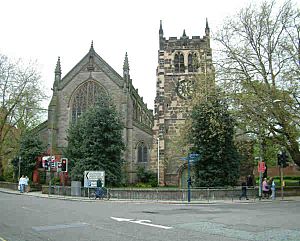St Werburgh's Church, Derby facts for kids
Quick facts for kids St Werburgh's Church, Derby |
|
|---|---|

St Werburgh's Church, Derby, showing the body of the church on the left, and the conserved tower on the right
|
|
| Lua error in Module:Location_map at line 420: attempt to index field 'wikibase' (a nil value). | |
| OS grid reference | SK 349 363 |
| Location | Derby, Derbyshire |
| Country | England |
| Denomination | Anglican |
| Website | https://www.stwderby.org |
| History | |
| Status | re-opened |
| Dedication | Saint Werburgh |
| Architecture | |
| Functional status | Active |
| Architect(s) | Sir Arthur Blomfield (rebuilding) |
| Architectural type | Church |
| Style | Gothic Survival, Gothic Revival |
| Completed | 1894 |
| Closed | 1990 |
St Werburgh's Church is an Anglican church located on Friargate in the city of Derby, England. It is a very old and important building. The church is listed as a Grade II* listed building. This means it is a special historic place.
A famous writer named Samuel Johnson (also known as Dr Johnson) got married here in 1735. He married Elizabeth Porter in this church.
The church has two main parts. These are the tower/chapel and the main church building. They are connected but you cannot walk directly between them inside. The tower and an old part called the chancel are looked after by the Churches Conservation Trust. The main church building was closed for worship in 1984. However, it reopened in September 2017. It is now part of the Holy Trinity Brompton Church network. People meet for worship every Sunday in the main church.
Contents
History of St Werburgh's Church
The church has a very long history, going back to medieval times. The oldest part that still stands today is the tower. It was rebuilt between 1601 and 1608. The chancel, which is a part of the church near the altar, was built in 1699.
Most of the church was rebuilt later, between 1893 and 1894. This was done using stone from a place called Coxbench quarry. The architect who designed this rebuilding was Sir Arthur Blomfield. He used a style called Gothic Revival, which looked like churches from the 15th century.
Changes Over the Years
St Werburgh's Church closed its doors for worship in 1984. The church's local area then joined with another church, St Alkmund's. Some important memorials and stained glass windows were moved to other churches. The church building was officially declared "redundant" in 1990.
After that, the main part of the church was used for other things. It was an indoor market and even a Chinese restaurant for a while. The building was then closed for seven years. But on September 17, 2017, St Werburgh's reopened as a church once again.
The tower and the chancel were given to the Churches Conservation Trust in 1989. The tower was repaired and improved in 2004. It now contains a small chapel, which is known as the "Johnson Chapel."
Samuel Johnson's Marriage
Samuel Johnson married Elizabeth Porter on July 9, 1735. Elizabeth, also called "Tetty," was a wealthy widow. Samuel was 25 years old at the time, and Elizabeth was 46. Neither of their families were very happy about the marriage. Their marriage lasted until Elizabeth passed away in 1752.
Architecture and Design
The church's tower is built in a style called Gothic Survival. The chancel, built in 1690, has been turned into a side chapel. This chapel still has many of its original features and furniture.
One special item is an amazing wrought iron cover for the baptismal font. It was made by a famous ironsmith named Robert Bakewell. The reredos, which is a screen behind the altar, has panels with the Ten Commandments, the Lord's Prayer, and the Apostles' Creed written on them. Above the reredos, you can see the royal coat of arms of Queen Anne.
The beautiful stained glass windows in the church were made by the studio of Charles Eamer Kempe. There is also a monument from 1832 created by Francis Leggatt Chantrey.
War Memorial
The chancel also has a war memorial on its wall. It was made by Arthur George Walker. This memorial is a bronze figure of Christ with his arms stretched out. Below it is a plaque. The words on the plaque say "Remember 1914–1918 / (Names) / Blessed are the Peacemakers." It lists the names of 47 men.
Church Organ
St Werburgh's Church has had an organ for a very long time, since at least 1750. A new organ by John Gray was first played on February 3, 1841. This was later replaced by another new organ from Walker and Sons of London. That organ was opened on December 14, 1872.
Over the years, the organ was repaired and made bigger several times. By 1905, after work by Henry Willis & Sons, it became a large instrument with four keyboards and 47 "speaking stops" (which control the different sounds). In 1989, the organ was sold to another church, All Saints in Newton Heath, Greater Manchester. However, it was never actually installed there.
Organists of the Church
Many talented musicians have played the organ at St Werburgh's Church. Here are some of them:
- F Roome (around 1766 to 1812)
- Edward William Gover (around 1841)
- Henry W. James (around 1846 to 1851)
- Edward Chadfield (1861 to 1872)
- Arthur Francis Smith (1872 to 1911)
- Norman Hibbert (1912 to 1941)
- Leslie Taylor (1941 to 1943)
- H. Stanley Mayes (1943 onwards)
- Dr Arthur Pope
- David Johnson
- Christopher Martin Thomas (1975 to 1981)
See also
- List of churches preserved by the Churches Conservation Trust in the English Midlands
- Grade II* listed buildings in Derby
- Listed buildings in Derby (Arboretum Ward)

